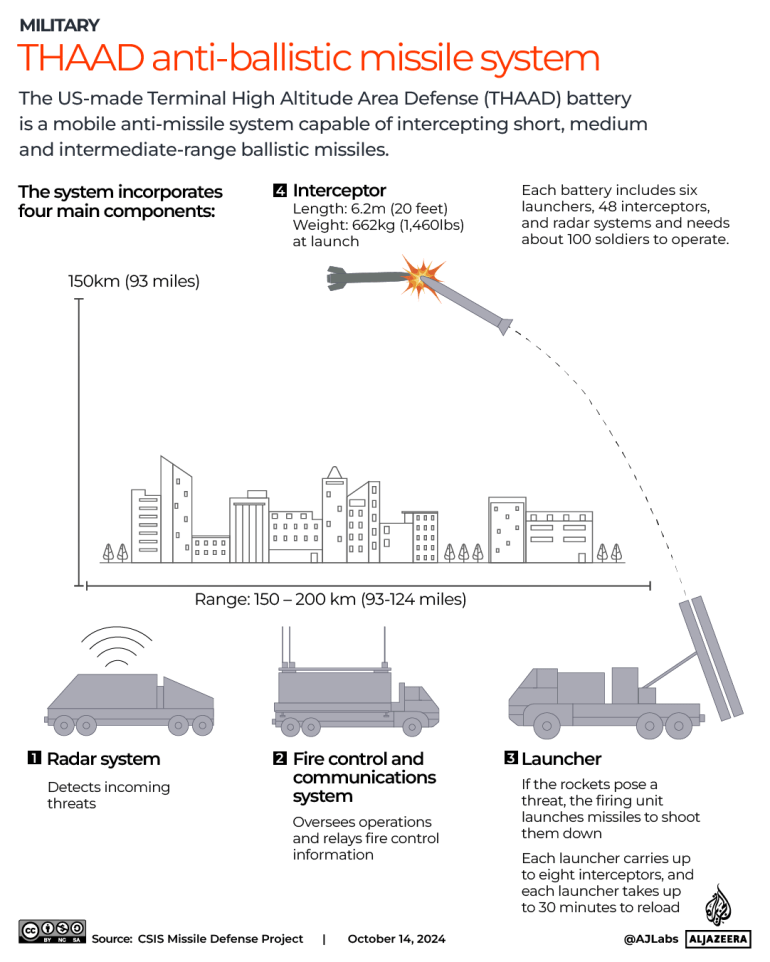What is the THAAD antimissile system that the US is sending Israel?

In its latest round of military assistance to Israel, the United States will send its advanced Terminal High Altitude Area Defense (THAAD) missile defence system.
The US will also send soldiers to operate the system, the Pentagon said on Sunday.
It is unclear when the deployment will take place.
Here’s why the US is deploying the THAAD system in Israel now:
What is the THAAD system?
THAAD is an advanced missile defence system that uses a combination of radar and interceptors to thwart short-, medium- and intermediate-range ballistic missiles. Its missiles have a range of 150 to 200km (93 to 124 miles), and the system is made by US defence and aerospace manufacturer Lockheed Martin.
It can intercept missiles inside and outside Earth’s atmosphere during their final stage of flight, which begins when the detached warhead re-enters Earth’s atmosphere and ends upon detonation, according to the Center for Arms Control and Non-Proliferation.
How does the THAAD system work?
According to an April report by the Congressional Research Service, THAAD batteries usually are made up of 95 soldiers, six truck-mounted launchers, 48 interceptors – eight for each launcher – one radar system, and a fire control and communications component.
The number of launchers and interceptors can vary.
THAADs do not carry an explosive warhead, which allows them to reach high altitudes quickly. Rather than exploding on impact with incoming ballistic missiles to neutralise them, THAAD interceptors use kinetic energy – the energy generated through its mass being in motion – to set off the missile.
What it cannot do is fend off smaller, simpler weapons such as drones used by groups including Hamas and Yemen’s Houthis, Al Jazeera’s Mike Hanna reported from Washington, DC. This is because the drones are small and do not approach from a high altitude.
How much does it cost?
One THAAD battery costs from $1bn to $1.8bn, according to Hanna.
How many THAAD batteries are there?
According to the Congressional Research Service report, the US army has deployed seven THAAD batteries, including to South Korea and Guam.
Does Israel already have THAAD batteries?
According to a statement published by the US Department of Defense on Sunday, the US previously deployed a THAAD battery to southern Israel in 2019 “for training and an integrated air defense exercise”.
However, this battery was taken back to the US after the exercise, Hanna said.
The statement added that the US deployed a THAAD battery in the Middle East “to defend American troops and interests in the region” after the Hamas attacks on Israel on October 7, 2023, without specifying the country it was deployed to.
Israel’s air defences currently use three systems: The Iron Dome intercepts short-range missiles from 4 to 70km (2.5 to 43.5 miles), David’s Sling intercepts medium-range missiles from 40 to 300km (24.5 to 186 miles) and the Arrow System intercepts long-range missiles up to 2,400km (1,491 miles) away.
Hanna said the THAAD and Iron Dome systems can work together to protect from a higher altitude and minimise damage from a longer distance.

Why is the US sending the system to Israel now?
“In the last Iranian attack, Iran improvised something we had never seen before,” military analyst Elijah Magnier said, referring to Iran’s attack on Israel on October 1 when it fired nearly 200 missiles on major cities and towns.
Iran launched the missiles “into three corridors, or three locations, making it impossible for any interceptor to bound them all”, Magnier said.
Iranian state media said Fattah hypersonic ballistic missiles were used for the first time, a claim Al Jazeera was unable to independently verify.
Fattah, unveiled in 2023, is a missile the US has never come up against, and Washington wants to “test” whether THAAD can intercept it, Magnier said.
On Sunday, a statement said US Defense Secretary Lloyd Austin authorised the deployment of a THAAD system to Israel to help boost the country’s air defences.
“This action underscores the United States’ ironclad commitment to the defense of Israel … from any further ballistic missile attacks by Iran,” the statement added.
Why are US soldiers coming with it?
“The [THAAD] systems are so complex that it requires a crew of 94 to operate – a trained crew of 94 – and these will be US soldiers,” Hanna reported from Washington, DC.
Magnier explained that the US forces are accompanying the THAAD system because they are trained to operate it and there is no time to train the Israeli army.
While it is uncertain when the THAAD will arrive in Israel, “once the THAAD arrives, any time would be good for Israel to launch the attack and Iran’s reaction would not be imminent,” Magnier said.
He added that the soldiers might return to the US if Iran launches an attack on Israel.

Could Israel receive more THAAD batteries in the future?
The is unlikely, Hanna said.
This is because the THAAD covers a wide area and one battery is enough for Israel’s size, especially given the assumption that the missiles will hit Israel from Iran only, he explained.
Additionally, the THAAD is a limited resource for the US, and manufacturing more batteries takes time, Hanna said, likening the complex manufacturing process to that of a jet airliner.
However, interceptor missiles are easier to replenish.
Source: Aljazeera
Leave a Reply